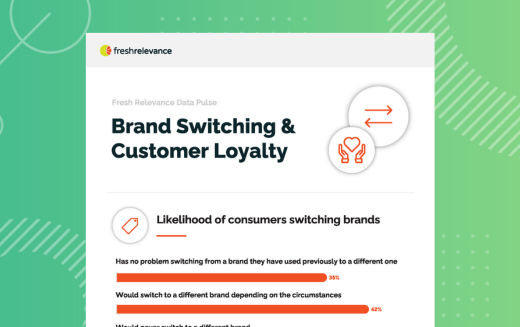Brand switching and customer loyalty

Customer loyalty is changing. With more shoppers buying online as a result of the pandemic and the ability to visit a new store at the touch of a button, many consumers are more willing to switch brands and abandon old favorites. This means eCommerce businesses need to stay on top of consumer trends and work hard to keep their customers from jumping ship to a competitor.
Together with Censuswide, we polled 2000 consumers across the UK to find out exactly how willing shoppers are to switch brands, how the Covid-19 pandemic has affected their brand loyalty, what would make them switch brands and whether they switched brands more often during this year’s Black Friday and Christmas shopping season.
Key takeaways:
- Brands need to up their customer loyalty game because more than 1 in 3 consumers have no problem switching brands and almost half of consumers would switch to a different brand depending on the circumstances.
- Consumer behavior is changing. Nearly 1 in 4 consumers purchased from a brand they hadn’t tried before during peak season 2021 and have been switching brands more frequently since the Covid-19 pandemic began.
- There are a number of ways to keep customers loyal and prevent them from switching brands, such as optimizing your out of stock pages, implementing a referral program, segmenting returning customers to target them with loyalty perks, and setting up triggered emails to improve customer service.
Likelihood of consumers to switch brands

The data shows that eCommerce businesses need to work hard to keep consumers from switching to a different brand. More than 1 in 3 consumers (35%) frequently try new brands and have no problem switching from a brand they have used previously to a different one. Almost half of consumers (42%) say they prefer shopping with brands they have previously shopped with but would switch to a different brand depending on the circumstances. We will delve further into common circumstances that would make consumers switch brands in the next section. Conversely, almost 1 in 4 consumers (23%) say they would never switch to a different brand. This was especially the case for the baby boomer age group, where almost 1 in 3 (31%) selected this option.
Why consumers switch brands

Above all, consumers are price sensitive, with 40% of respondents having switched brands in the past because the new brand offered a better price. This price sensitivity increases with age, with almost half of baby boomers (47%) selecting this option.
The desire to try something new is also a key reason consumers have switched brands in the past, with 39% of respondents selecting this option. Whilst it might be unrealistic to frequently add new products to your store, your business could keep things fresh and engage your shoppers with targeted promotions, for example recommending related or similar products to the ones the customer usually buys so shoppers can try something new without leaving your brand.
Almost 1 in 3 consumers (30%) have switched brands because their favorite product was sold out, and although you can’t control products going out of stock, you can control your out of stock pages. Try optimizing these pages with product recommendations for similar products and send triggered back in stock emails to let shoppers know when a product they browsed has come back in stock.
Learn more: 3 ways to optimize your out of stock pages
1 in 4 consumers have switched brands because a new brand was recommended to them by family and friends, which indicates the value of referral programs in acquiring new customers.
Why consumers stay loyal to brands

Price is important to consumers, with 44% saying they stay loyal to brands that offer great value for money. Again, this increases throughout the age groups, with over half of baby boomers (51%) selecting this option.
Convenience is another important factor when it comes to loyalty, with over 1 in 4 consumers (27%) staying loyal to brands who are convenient (for example brands who make it easy to buy again as they save customer and payment details).
With 1 in 4 consumers staying loyal to brands who reward customers for loyalty and make customers feel valued, eCommerce businesses should segment returning customers and target them with perks such as a loyalty points program, special discounts or early access to sales.
Learn more: Fresh Relevance Loyalty Report
Almost 1 in 4 consumers (24%) are loyal to brands that offer great customer service, for example responding to and resolving issues quickly. Triggered emails can help ramp up your customer service by sending relevant, timely information to shoppers, such as post-purchase, replenishment and price drop emails for example.
How the Covid-19 pandemic has affected customer loyalty

Whilst almost half of consumers (47%) say they’ve been switching brands at the same frequency during the Covid-19 pandemic as before it began, nearly 1 in 4 consumers (23%) have been switching brands more frequently since the pandemic began. This is a significant number and demonstrates how consumer behavior has changed over the last couple of years.
Brand switching habits over peak season 2021

Whilst 69% of consumers said they didn’t try a new brand during Black Friday or Christmas 2021, nearly 1 in 4 consumers (23%) did. This was particularly the case for younger consumers, with 38% of respondents aged 16-34 saying they purchased from a brand for the first time during this period. Again, this perhaps reflects changing consumer behavior and is something for eCommerce businesses to be aware of next peak season.
Learn more: The New Normal Festive Shopping Report
Download the infographic to view and save all the data visualizations shown here in one place.
 01/14/2022
01/14/2022 